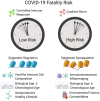Why does COVID-19 disproportionately affect older people?
- PMID: 32470948
- PMCID: PMC7288963
- DOI: 10.18632/aging.103344
Why does COVID-19 disproportionately affect older people?
Abstract
The severity and outcome of coronavirus disease 2019 (COVID-19) largely depends on a patient's age. Adults over 65 years of age represent 80% of hospitalizations and have a 23-fold greater risk of death than those under 65. In the clinic, COVID-19 patients most commonly present with fever, cough and dyspnea, and from there the disease can progress to acute respiratory distress syndrome, lung consolidation, cytokine release syndrome, endotheliitis, coagulopathy, multiple organ failure and death. Comorbidities such as cardiovascular disease, diabetes and obesity increase the chances of fatal disease, but they alone do not explain why age is an independent risk factor. Here, we present the molecular differences between young, middle-aged and older people that may explain why COVID-19 is a mild illness in some but life-threatening in others. We also discuss several biological age clocks that could be used in conjunction with genetic tests to identify both the mechanisms of the disease and individuals most at risk. Finally, based on these mechanisms, we discuss treatments that could increase the survival of older people, not simply by inhibiting the virus, but by restoring patients' ability to clear the infection and effectively regulate immune responses.
Keywords: COVID-19; aging; cytokine storm; epigenetic clock; immunity.
Conflict of interest statement
Figures



References
-
- Zhu N, Zhang D, Wang W, Li X, Yang B, Song J, Zhao X, Huang B, Shi W, Lu R, Niu P, Zhan F, Ma X, et al., and China Novel Coronavirus Investigating and Research Team. A novel coronavirus from patients with pneumonia in China, 2019. N Engl J Med. 2020; 382:727–33. 10.1056/NEJMoa2001017 - DOI - PMC - PubMed
-
- Worldometer. 2020. https://www.worldometers.info/coronavirus/coronavirus-age-sex-demographics/
-
- World-Health-Organization. (2020). Coronavirus disease 2019 (COVID-19) Situation Report.
-
- Williamson E, Walker AJ, Bhaskaran KJ, Bacon S, Bates C, Morton CE, Curtis HJ, Mehrkar A, Evans D, Inglesby P, Cockburn J, Mcdonald HI, MacKenna B, et al. OpenSAFELY: factors associated with COVID-19-related hospital death in the linked electronic health records of 17 million adult NHS patients. medRxiv. 2020.
Publication types
MeSH terms
Grants and funding
LinkOut - more resources
Full Text Sources
Medical

